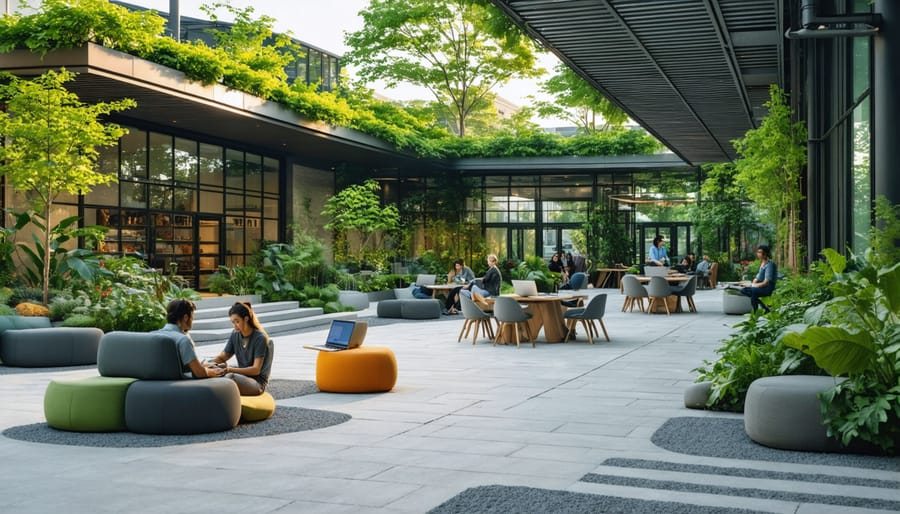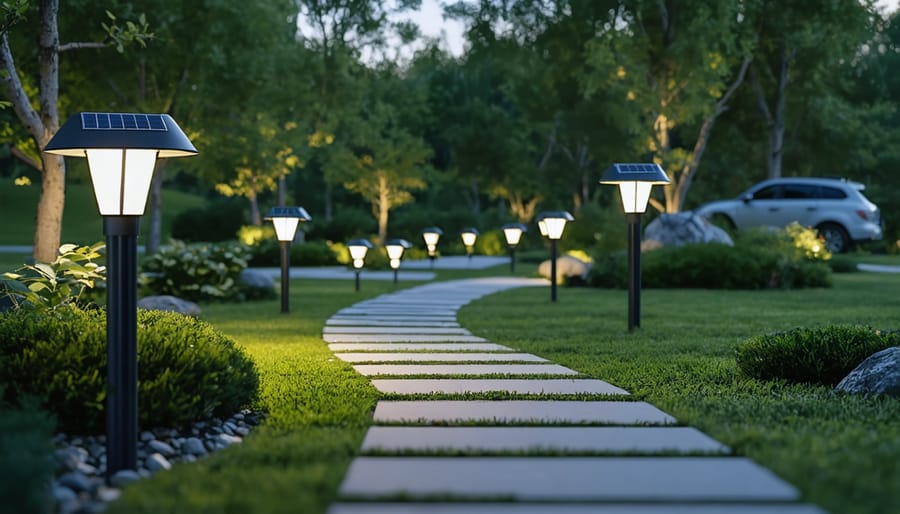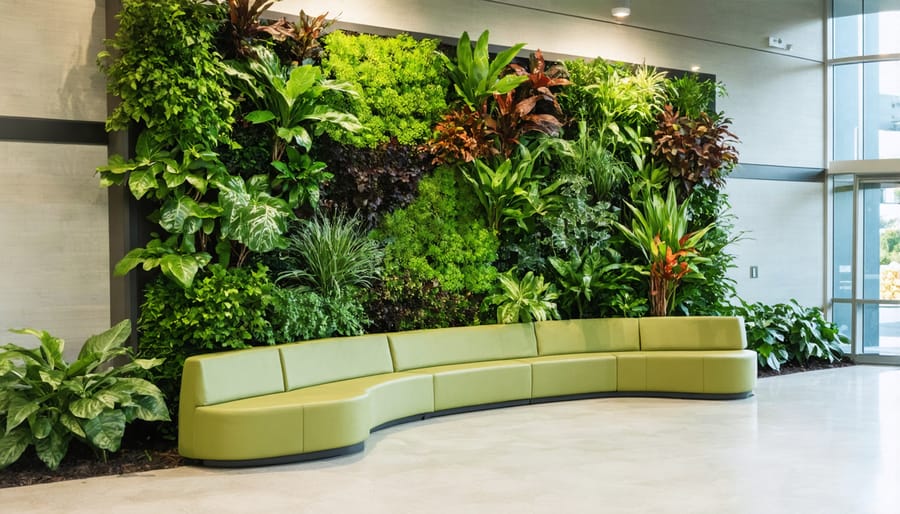Beautiful Outdoor Workspaces That Save Money and the Planet

Transform your outdoor space into a professional outdoor workspace while nurturing the environment through smart landscape architecture. Install permeable pavement systems that capture and filter rainwater, reducing runoff by up to 90% while creating functional pathways and work areas. Position native shade trees strategically around seating zones to naturally cool the space, cutting cooling costs by 25% and providing essential wildlife habitat. Incorporate modular, recycled materials for ground covers and furniture that adapt to changing needs while minimizing environmental impact. These sustainable design choices not only create comfortable, productive outdoor work environments but also significantly reduce maintenance costs and resource consumption over time. Whether you’re planning a compact garden office or reimagining a corporate campus, sustainable landscape architecture combines ecological responsibility with practical functionality to deliver lasting value for both people and the planet.
Smart Water Management Solutions
Rain Gardens and Bioswales
Rain gardens and bioswales are innovative landscape features that transform how we manage stormwater while creating beautiful, functional spaces. These natural filtration systems work by collecting rainwater runoff from roofs, driveways, and other hard surfaces, allowing it to slowly seep into the ground rather than overwhelming storm drains.
Rain gardens are shallow depressions filled with deep-rooted native plants that naturally filter pollutants from water. They’re particularly effective near downspouts or in low-lying areas where water naturally collects. When properly designed, these gardens can remove up to 90% of nutrients and chemicals and up to 80% of sediments from rainwater runoff.
Bioswales, meanwhile, are linear channels designed to concentrate and convey stormwater runoff while filtering out pollution and debris. These gently sloping drainage courses are often lined with vegetation, rocks, and other natural materials that slow water flow and trap contaminants. They’re particularly effective along driveways, parking lots, and other paved surfaces.
Both features require minimal maintenance once established and can significantly reduce irrigation needs. They also create valuable wildlife habitat, supporting local pollinators and birds. For property owners, these systems offer practical benefits beyond sustainability – they help prevent flooding, reduce erosion, and can add significant visual appeal to any landscape while naturally managing water resources.

Drought-Resistant Plant Selection
Selecting drought-resistant plants is a cornerstone of sustainable landscape design, offering both environmental benefits and reduced maintenance needs. Native plants like lavender, sage, and yarrow naturally thrive in local conditions while requiring minimal watering. These hardy perennials not only save water but also create stunning visual displays throughout the seasons.
Ornamental grasses, such as Blue Fescue and Mexican Feather Grass, provide year-round interest and excellent drought tolerance. Their deep root systems help prevent soil erosion while requiring very little supplemental water once established. Succulents and cacti are perfect choices for arid regions, offering unique textures and shapes while thriving in hot, dry conditions.
For groundcover, consider options like Sedum and Creeping Thyme, which create dense mats of foliage that suppress weeds and retain soil moisture. Mediterranean herbs like rosemary and oregano serve double duty as both drought-resistant plants and culinary resources.
Trees such as Olive and Desert Willow provide essential shade while consuming minimal water. When planning your drought-resistant landscape, group plants with similar water needs together, a practice known as hydrozoning. This approach ensures efficient water use and creates visually cohesive plant communities that naturally complement each other.
Remember to incorporate a layer of mulch around your chosen plants to retain moisture and reduce evaporation, further enhancing their drought-resistant qualities.

Energy-Efficient Outdoor Lighting
Solar-Powered Options
Harnessing solar power has become an increasingly popular choice for sustainable outdoor lighting solutions. Solar-powered fixtures offer dual benefits: they reduce energy costs while minimizing environmental impact. Modern solar lights come in various styles, from path markers and spotlights to motion-sensor security lights, making them versatile additions to any landscape design.
Installing solar lighting requires minimal infrastructure changes since there’s no need for electrical wiring. Simply position the fixtures where they’ll receive adequate sunlight during the day, and they’ll automatically illuminate your space at night. Many systems now include smart features like adjustable brightness levels and timing controls, allowing you to customize lighting based on your needs.
For maximum efficiency, consider positioning solar panels on pergolas or shed roofs where they can capture optimal sunlight. These installations can power not just lights but also small water features or tool charging stations. The initial investment in quality solar equipment typically pays for itself through reduced energy bills within two to three years.
To ensure reliable performance year-round, look for fixtures rated for your climate zone and clean panels regularly. This simple maintenance routine helps maintain optimal charging capacity and extends the life of your solar lighting system.
LED and Motion Sensor Systems
Modern LED and motion sensor systems represent a significant advancement in sustainable landscape lighting, offering both energy efficiency and enhanced security. These smart lighting solutions automatically adjust to natural light levels and movement, ensuring illumination only when needed. By incorporating motion sensors, pathways and work areas light up as people approach and dim when vacant, reducing unnecessary energy consumption.
LED fixtures consume up to 75% less energy than traditional halogen lights while lasting significantly longer, making them a cost-effective choice for long-term outdoor lighting. Many systems now come with programmable timers and smartphone controls, allowing property owners to customize lighting schedules based on usage patterns and seasonal changes.
For maximum sustainability, consider solar-powered LED lights, which harness renewable energy during the day to power evening illumination. These fixtures are particularly effective for highlighting pathways, work areas, and security zones without increasing energy costs. When planning your lighting layout, focus on essential areas like entrances, walkways, and task spaces rather than blanket lighting the entire landscape. This targeted approach not only saves energy but also reduces light pollution, supporting local wildlife and creating a more natural nighttime environment.
Sustainable Materials and Structures
Recycled and Local Materials
Choosing sustainable materials for your landscape projects doesn’t mean compromising on quality or aesthetics. By incorporating weather-resistant workspace materials made from recycled content, you’re not only creating durable outdoor spaces but also reducing environmental impact.
Local stone and reclaimed wood are excellent choices for pathways, borders, and decorative elements. These materials often come with fascinating histories and unique characteristics that add character to your landscape. Consider salvaged brick or concrete for retaining walls and pavers, which can be sourced from local demolition projects at competitive prices.
For outdoor structures and furniture, look for certified sustainable wood or composite materials made from recycled plastic and wood fibers. These alternatives offer exceptional durability while keeping waste out of landfills. Many manufacturers now produce deck boards and fencing using up to 95% recycled materials without sacrificing performance.
Native plant materials can be incorporated into living walls and green roofs, providing natural insulation while supporting local ecosystems. When selecting mulch and soil amendments, opt for locally produced compost and wood chips from tree maintenance operations in your area. This approach not only reduces transportation emissions but also supports your local economy.
Remember to check the sourcing documentation for materials claiming to be recycled or sustainable. Legitimate suppliers will provide certification and transparently share information about their products’ environmental impact.
Green Roofs and Living Walls
Green roofs and living walls represent innovative approaches to integrating nature into built environments, offering both aesthetic appeal and significant environmental benefits. These verdant installations transform ordinary surfaces into thriving ecosystems that work hard for your property.
A green roof system consists of several layers, including waterproofing, drainage, growing medium, and carefully selected plants. These living rooftops help manage stormwater runoff by absorbing up to 80% of rainfall, while also providing natural insulation that can reduce heating and cooling costs by 20-30%. They’re particularly effective in urban areas, where they help combat the heat island effect and create habitats for local wildlife.
Living walls, also known as vertical gardens, make excellent use of vertical space while purifying the air and reducing noise pollution. These systems can be installed both indoors and outdoors, featuring a mix of ornamental and edible plants that create stunning visual impact. For maximum sustainability, consider incorporating native plant species that require minimal maintenance and support local pollinators.
When planning these features, it’s essential to work with qualified professionals who can ensure proper structural support and irrigation systems. While the initial investment may be higher than traditional surfaces, the long-term benefits in energy savings, environmental impact, and property value make green roofs and living walls worthwhile additions to any sustainable landscape design.

Wildlife-Friendly Design Elements
Native Plant Selection
Native plant selection forms the backbone of sustainable landscape architecture, offering multiple benefits for both the environment and property owners. These plants have evolved alongside local wildlife, creating natural habitats that support birds, butterflies, and beneficial insects. When choosing native plants, consider your specific climate zone and soil conditions to ensure optimal growth and minimal maintenance requirements.
Native plants typically require less water than non-native species, as they’re already adapted to local rainfall patterns. They also tend to be more resistant to local pests and diseases, reducing the need for chemical pesticides and fertilizers. This natural resilience translates to lower maintenance costs and time investment for property owners.
To create a thriving ecosystem, incorporate a mix of flowering plants, shrubs, and trees that bloom at different times throughout the growing season. This approach ensures a consistent food source for pollinators and creates year-round visual interest. Consider including plants like butterfly weed, native grasses, and berry-producing shrubs that provide both aesthetic value and wildlife benefits.
When planning your native plant landscape, group species with similar water and sunlight needs together. This practice, known as hydrozoning, makes maintenance more efficient and helps ensure plant success. Remember to leave some natural debris and fallen leaves in garden beds, as these materials provide essential shelter for beneficial insects and natural soil enrichment.
Habitat Creation
Creating habitats within your landscape design isn’t just about aesthetics – it’s about fostering a thriving ecosystem that supports local wildlife while contributing to a more peaceful outdoor environment. Start by incorporating native plants that provide food and shelter for local species. Consider adding layers of vegetation, from ground covers to shrubs and trees, creating multiple habitats that support different wildlife needs.
Water features like small ponds or rain gardens serve dual purposes – they manage stormwater while providing essential resources for birds, insects, and amphibians. Installing bird feeders, houses, and bat boxes offers immediate shelter options while your planted habitat develops. Remember to include pollinator-friendly flowers that bloom throughout different seasons, supporting bees, butterflies, and other beneficial insects year-round.
Dead wood and brush piles, though often overlooked, create valuable microhabitats for beneficial insects and small animals. Consider leaving some areas of your landscape slightly wild, with fallen leaves and natural debris that provide shelter and nesting materials. Reduce or eliminate chemical pesticides to protect the food chain and maintain healthy soil biology.
Connect habitat areas where possible, creating wildlife corridors that allow animals to move safely through your landscape. Even small spaces can become valuable stepping stones in the larger ecological network of your neighborhood. By thoughtfully incorporating these habitat elements, your landscape becomes part of a larger solution for local biodiversity while maintaining its functionality as an outdoor space.
Embracing sustainable landscape architecture in outdoor workspaces offers a wealth of benefits that extend far beyond environmental protection. By implementing the practices discussed throughout this guide, property owners can create functional, beautiful spaces that reduce operational costs while supporting local ecosystems. Water-efficient designs can slash irrigation expenses by up to 50%, while thoughtful material choices and native plantings minimize maintenance requirements and enhance durability.
The return on investment for sustainable outdoor workspaces is compelling, with many projects reporting energy savings of 25-30% through strategic shade placement and green infrastructure. Moreover, these spaces consistently receive positive feedback from users, who report increased productivity and improved well-being when working in naturally designed environments.
Taking the first step toward sustainability doesn’t require a complete overhaul of your existing space. Start with simple changes like installing rain barrels, incorporating native plants, or adding solar-powered lighting. As you witness the benefits firsthand, you can gradually expand your sustainable practices.
Remember that every sustainable choice, no matter how small, contributes to a healthier planet while creating more resilient and enjoyable outdoor workspaces. By prioritizing environmental responsibility in landscape design, we’re not just investing in our properties – we’re investing in our future and setting an example for others to follow.

